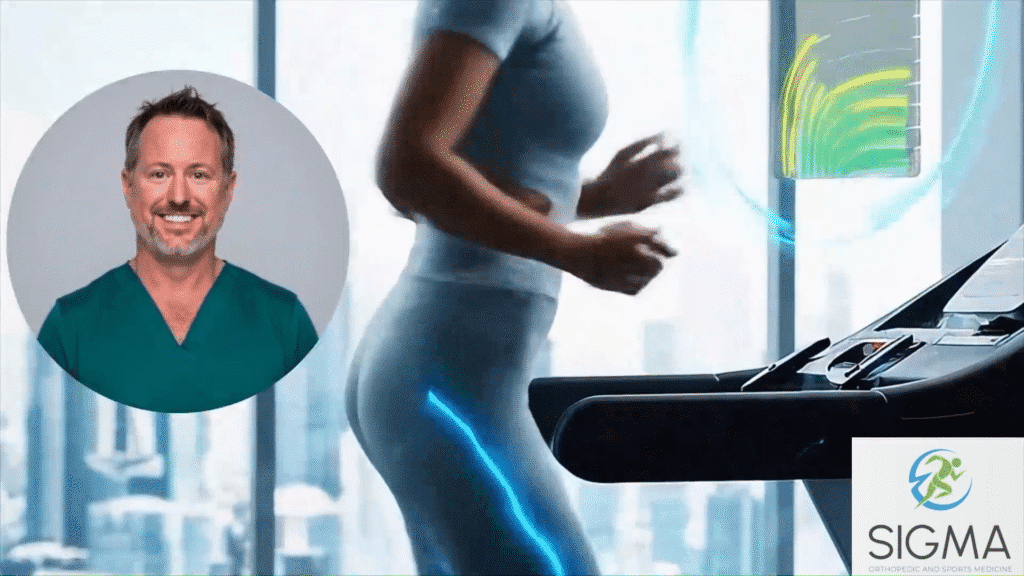Hip pain isn’t one diagnosis. It’s a complex system that demands accuracy, technology, and a surgeon who understands the full spectrum of causes.
At SIGMA, we believe hip osteoarthritis isn’t just a “wear-and-tear” problem — it’s an opportunity to apply elite-level strategies, precise diagnostics, and targeted interventions, inspired by fighter-pilot risk reduction and Six Sigma business optimization. If you’re experiencing hip pain, stiffness, or reduced mobility, you don’t simply have to “wait it out” or go straight to the operating room. Our approach begins by understanding your hip joint as the center of a high-performance system — analyzing alignment, biomechanics, cartilage health, muscle dynamics, load-transfer patterns, and long-term joint sustainability. With this mindset, we design a plan that blends advanced diagnostics, non-operative optimization, regenerative technologies, and, when necessary, precise surgical solutions—all tailored for active lives and high standards of performance.
Below you will find a brief video that walks you through how the SIGMA Approach transforms hip care: you’ll see how we assess the joint, apply evidence-based non-surgical options, and, when needed, execute a surgical solution with the precision, teamwork, and outcome focus you’d expect of an elite performance organization. Watch closely to understand how this model of care can renew your hip function, reduce pain, and support return to meaningful activity.
At SIGMA, hip osteoarthritis care is built around staging the disease, understanding your goals, and using a stepwise toolbox to relieve pain and preserve function. We combine advanced imaging, movement analysis, orthobiologics, and minimally invasive surgery with our 100-Days-to-Health recovery framework and objective outcome tracking.

In earlier stages—especially when hip OA overlaps with labral tears or FAI—arthroscopic surgery can address impingement, repair the labrum, and smooth unstable cartilage. For carefully selected patients, this can reduce pain and help delay the need for a hip replacement.
When the joint is truly worn out, a total hip replacement can be life-changing. At SIGMA, we use modern implants, advanced planning tools, and, where appropriate, minimally invasive and robotic-assisted techniques to optimize implant position and function. We then plug you into our 100-Days-to-Health recovery roadmap and physical therapy protocols so progress is measured, not guessed.
Activity modification and load management Weight optimization and anti-inflammatory strategies Tailored physical therapy to improve hip strength, mobility, and gait mechanics
Orthobiologics & Regenerative Options For select patients with early to moderate hip OA, we may discuss PRP or bone marrow–derived cell concentrates to help modulate inflammation and support joint health. These biologic injections are not a cure for arthritis, but for the right patient they can be part of a joint preservation strategy to reduce pain and potentially delay surgery. Evidence is evolving, and we’ll discuss benefits and limitations openly before proceeding.
Viscosupplementation (Hyaluronic Acid) In some cases, we use hyaluronic acid injections to improve joint lubrication and comfort. This is used less often in the hip than the knee, and results can vary, but it may provide short-term relief for carefully selected patients.
For patients who are not ready for surgery—or are poor surgical candidates—we may use nerve-targeting procedures like radiofrequency ablation to reduce pain signals from the arthritic hip joint for several months at a time.
Advanced Physical Therapy Techniques Aquatic therapy to unload the joint while building strength Neuromuscular electrical stimulation (NMES) to help activate key muscles around the hip and improve stability as part of a comprehensive program


1. Regenerative Medicine:
– Platelet-Rich Plasma (PRP) Therapy:
• Autologous blood product rich in growth factors
• May promote tissue healing and reduce inflammation
• Mixed evidence for efficacy in hip OA
– Stem Cell Therapy:
• Utilizes mesenchymal stem cells (MSCs)
• Potential to regenerate cartilage and reduce inflammation
• Still considered experimental with ongoing clinical trials
2. Viscosupplementation:
• Intra-articular injection of hyaluronic acid
• Aims to improve joint lubrication and shock absorption
• Less commonly used in hip OA compared to knee OA
• Limited evidence for long-term efficacy in hip OA
3. Radiofrequency Ablation:
• Targets sensory nerves supplying the hip joint
• Can provide pain relief for 6-12 months
• Minimally invasive procedure
• May be considered for patients who are poor surgical candidates
4. Advanced Physical Therapy Techniques:
– Aquatic Therapy:
• Reduces joint loading while improving strength and flexibility
• Particularly beneficial for obese patients or those with severe pain
– Neuromuscular Electrical Stimulation (NMES):
• Enhances muscle strength and joint stability
• May improve functional outcomes when combined with exercise
5. Orthobiologics:
• Includes growth factors, cytokines, and other biologically active substances
• Aimed at promoting tissue repair and reducing inflammation
• Research ongoing to determine optimal formulations and delivery methods
1. Hip Arthroscopy:
• Minimally invasive procedure for early-stage OA
• Can address labral tears, femoroacetabular impingement, and loose bodies
• May delay progression to total hip arthroplasty in select patients
• Limited efficacy in advanced OA
2. Hip Resurfacing:
• Preserves more bone stock than total hip arthroplasty
• Typically used in younger, active patients
• Metal-on-metal bearings have fallen out of favor due to concerns about metal ion release
• Newer ceramic-on-metal options show promise
3. Total Hip Arthroplasty (THA):
– Traditional Approaches:
• Posterior, lateral, and anterior approaches
• Each with specific advantages and potential complications
– Minimally Invasive THA:
• Smaller incisions and less tissue disruption
• Potential for faster recovery and shorter hospital stays
• Requires specialized training and may not be suitable for all patients
4. Robotic-Assisted THA:
• Utilizes computer navigation and robotic arm technology
• Improves accuracy of implant positioning
• May lead to better functional outcomes and longevity
• Higher initial costs but potential for long-term cost-effectiveness
5. Custom 3D-Printed Implants:
• Tailored to patient’s specific anatomy
• Particularly useful in complex cases or revision surgeries
• May improve implant fit and longevity
• Limited long-term data available
6. Dual Mobility Hip Implants:
• Designed to reduce dislocation risk
• Particularly beneficial for patients at high risk of instability
• May allow for greater range of motion
7. Ceramic-on-Ceramic Bearings:
• Extremely low wear rates
• Reduced risk of osteolysis compared to metal-on-polyethylene
• Potential concern for ceramic fracture, though rare with modern materials
8. Highly Cross-linked Polyethylene:
• Significantly reduced wear rates compared to conventional polyethylene
• May extend implant longevity
• Used in combination with ceramic or metal femoral heads
9. Cementless Fixation:
• Relies on bone ingrowth for long-term stability
• Particularly advantageous in younger, more active patients
• Improved longevity compared to cemented implants in many studies
10. Hip Osteotomy:
• Joint-preserving surgery for select patients with hip dysplasia or femoroacetabular impingement
• Can delay or prevent the need for THA in some cases
• Complex procedure with a prolonged recovery period
1. Cartilage Regeneration Techniques:
• Autologous chondrocyte implantation (ACI) adapted for hip OA
• Matrix-induced autologous chondrocyte implantation (MACI)
• Still in experimental stages for hip OA
2. Gene Therapy:
• Targeting specific genes involved in OA pathogenesis
• Potential to modify disease progression
• Currently in preclinical and early clinical trial stages
3. Nanotechnology:
• Development of nanoparticle drug delivery systems
• Potential for targeted therapy and improved drug efficacy
• Research ongoing for application in hip OA
4. Wearable Technology:
• Smart implants with embedded sensors
• Real-time monitoring of implant function and patient activity
• May allow for early detection of complications and personalized rehabilitation
5. Augmented Reality in Surgery:
• Enhanced visualization during hip procedures
• Potential to improve surgical precision and outcomes
• Integration with robotic systems for advanced surgical planning and execution
The landscape of advanced treatment options for hip osteoarthritis is rapidly evolving. While total hip arthroplasty remains the gold standard for end-stage disease, numerous innovations are expanding the therapeutic arsenal. Non-surgical options like regenerative medicine and advanced physical therapy techniques offer potential alternatives for patients seeking to delay or avoid surgery. Surgical advancements, including robotic-assisted procedures, custom implants, and improved bearing surfaces, continue to enhance outcomes and implant longevity.
As we look to the future, emerging technologies such as cartilage regeneration, gene therapy, and nanotechnology hold promise for further improving our ability to manage hip OA. However, it is crucial to note that many of these advanced treatments require further research to establish their long-term efficacy and safety profiles.
The choice of treatment should be tailored to each patient’s individual needs, considering factors such as age, activity level, comorbidities, and personal preferences. A multidisciplinary approach, involving orthopedic surgeons, physiatrists, physical therapists, and pain management specialists, is often necessary to optimize outcomes in the management of hip osteoarthritis.
As clinicians, we must stay informed about these advancing treatment options while maintaining a critical eye on the evolving evidence base. This will allow us to provide our patients with the most appropriate and effective care in the management of this challenging condition.